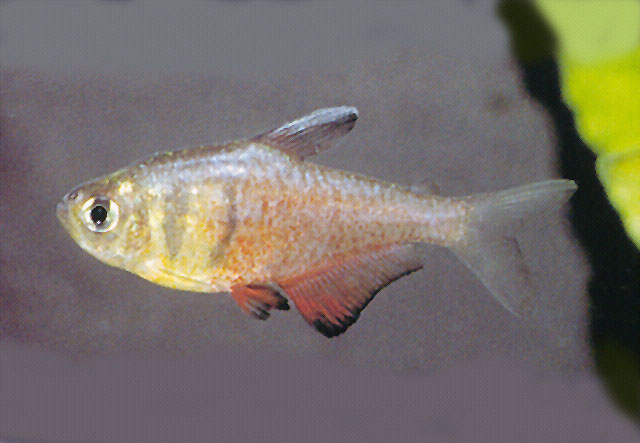| Characidae (Characins; tetras), subfamily: Stethaprioninae |
| 2.61 cm SL (male/unsexed) |
|
benthopelagic; freshwater; pH range: 5.80000019073486 - 7.80000019073486; dH range: 5 - 25; depth range - 0 m |
| South America: Brazil in streams and coastal rivers of Rio de Janeiro, in Guanabara bay basin, middle rio Paraíba do Sul basin and rio Guandu basin, and upper rio Tietê drainage (upper rio Paraná basin, São Paulo) (Ref. 96863). Thought to be extinct in the wild (Ref. 89952). |
|
Dorsal soft rays (total): 11-12; Anal soft rays: 24-29; Vertebrae: 31-32. Hyphessobrycon flammeus is distinguished from other congeners (except H. bifasciatus, H. balbus, H. chocoensis, H. columbianus, H. condotensis, H. griemi, H. igneus, H. itaparicensis, H. panamensis, H. savagei, H. sebastiani, H. tortuguerae, and H. weitzmanorum) by having two humeral spots vertically elongated and lacking caudal peduncle blotch. It can be diagnosed from aforementioned species by having 5-8 maxillary teeth (vs. 1-3 in H. balbus, 1-2 in H. bifasciatus and H. igneus, 3 in H. condotensis and H. panamensis, 2-3 in H. griemi, 1-4 in H. savagei, 2 in H. chocoensis and H. sebastiani, 9-10 in H. tortuguerae), caudal fin hyaline (vs. caudal fin with black median stripe in H. weitzmanorum), no longitudinal stripe dark and second humeral spot conspicuous as well as first humeral spot (vs. faint longitudinal stripe dark and second humeral spot less defined than first in H. weitzmanorum) (Ref. 96863).
Description: Dorsal-fin rays ii,9 or 10; anal-fin rays iv,20- 25; pectoral-fin rays i,9-11; pelvic-fin rays i,6 or 7; five or six scale rows between lateral line and pelvic-fin origin (Ref. 96863). |
| Inhabits small streams of slow flowing, dark-brown or clear water, shaded by small forests. Occurs also in small streams with clear water and sandy bottom. Prefers habitats with vegetation and streams with slow flowing water, living in depths not superior to 50 c and water temperature from 22°-28°C. Forms relatively numerous schools with agonistic interaction among alpha males. Feeds on small insects, worms and plants. Female lays around 200 to 330 oocytes on rocks, plants, or submerged debris; after that, the male releases the sperm for fertilization. The eggs hatch in about 2-3 days. Longevity is around four years (Ref. 96863). In tank, female lays 200 to 300 eggs which hatch in 2 to 3 days (Ref. 7020). Aquarium keeping: in groups of 5 or more individuals; minimum aquarium size 60 cm (Ref. 51539). |
|
Endangered (EN); Date assessed: 07 November 2018 (B1ab(i,iii)) Ref. (130435)
|
| harmless |
|
Source and more info: www.fishbase.org. For personal, classroom, and other internal use only. Not for publication.

